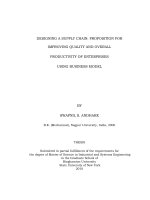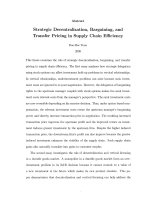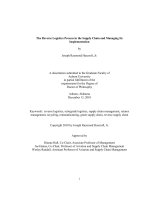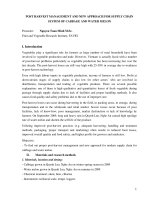ZARA supply chain (3)
Bạn đang xem bản rút gọn của tài liệu. Xem và tải ngay bản đầy đủ của tài liệu tại đây (21.06 MB, 28 trang )
SUPPLY CHAIN
ANALYSIS
LECTURER: HO THI HONG XUYEN
GROUP: TOKTOK
2
Member
Phạm Thúy Hiền
Nguyễn Thị Ánh Tuyết
19124041
19124046
Nguyễn Thế Trung
Nguyễn Hoàng Nhật Quyên
Hà Thị Thu Huyền
19124063
19124073
201204185
3
CONTENTS
1. ABOUT ZARA
2. SUPPLY CHAIN MODEL
3. SUPPLY CHAIN COMPONENTS
4. STRENGTHS AND WEAKNESSES
5. CONCLUSION
REFERENCES
4
I. ABOUT ZARA
Zara is a Spanish fashion clothing manufacturer
and retailer, formed in the 1970s
Zara mainly targets young and urban female
customers and acceptable prices are offered
Zara is not a world leader in cloth designs, but it
is a highly sensitive and flexible fashion trend
follower.
6
I I . SUPPLY CHAI N MODEL
7
Zara’s Fashion Retail Supply Chain Strategies
8
ZARA global distribution center "the cube"
9
III. SUPPLY CHAIN
COMPONENTS
10
CLOSED CYCLE OF THE
ZARA SUPPLY CHAIN
1
Product design
3
Sourcing and production
2
Raw material
4
Product distribution
procurement cycle
5
Sales
cycle
11
1. PRODUCT DESIGN
In
terms
of
fashionable
inspired
famous
by
design,
clothes
the
Zara
with
work
designers,
but
sells
designs
of
some
they
are
not affiliated with these designers
to design their products.
12
2. RAW MATERIAL PROCUREMENT CYCLE
Buy cheap raw materials from many
kingdoms in Spain, India, Middle East
region, ...
Zara has its main design
headquarters in Spain and has
strict links with its
offices/purchasing networks in
many places such as: Hong
Kong, Beijing, Barcelona, ...
13
3 Sourcing and production cycle
Zara produces 60% of their default
garments in servers around Arteixo
40% in Africa and Asia, where semifashion and design basics are
produced.
Zara only works with 20 main
suppliers for 75% of finished products,
14
All Zara products, no matter where they are made,
are sent back to DCs in Spain, which are then sent
to Zara stores worldwide.
Products will be shipped from DC to warehouses in
select
local
schools,
then
sent
to
Zara
stores
by
third-party logistics companies.
4.
The market does not have domestic goods,
products
will
be
sent
directly
to
Zara
stores
75% of Zara products are shipped by truck
and 25% are shipped by air
5. SALE
In terms of format retail, Zara stores have premium
products that move in and out of the store quickly. Special,
Zara keeps less inventory
15
1
ZARA’S
SUPPLY CHAIN
APPROACH
16
Procurement Methodology
2
Deep Collaboration
3
Production Feedback
4
Local Manufacturing
5
Spare Capacity
6
Demand Forecasting
1. Procurement
Methodologies
Zara’s
work
Procurement
on
clothes
the
but
materials
on
team
number
the
needed
doesn’t
of
finished
number
to
16
of
raw
manufacture
the clothes. This helps reduce waste,
as
you
can
re-use
fabric
but
not
resell a piece of clothing that didn’t
meet
the
expectations.
A
great
example of how sustainability can be
improved
reduction.
in
parallel
to
cost
2. Deep Collaboration
Supplier relationships
are key and suppliers
are all close to Zara
factories and
collaborate tightly, so
Zara can order on an
everyday-need basis.
17
19
3. Production Feedback
Every day, store managers give
customer feedback to the
market specialists, who then
pass the information along to
the production & design teams.
This rapid feedback loop
enables a quick and agile
response to the market.
20
4. Local Manufacturing
Zara presents a drastically different approach than its competitors. Instead of
outsourcing
all
of
its
production
to
Asia
or
Eastern
Europe,
it
decided
to
manufacture its products in Galicia for items with a more unstable demand.
While lower-cost production could be achieved in other regions, the faster time
to market, reduced transportation costs and low exposure to changing tariffs
and politics outweigh that one factor. This reduces overall supply risk, with a
more narrow set of risks than posed by more extended, global supply chains.
This
also
helps
reduce
the
reduction in transportation.
overall
carbon
footprint
through
a
significant
21
5. Spare Capacity
Zara voluntarily keeps up to 85% of its
plants idle, in order to optimize the
response to demand changes all around
the world. Another interesting approach,
quite different to competitors that try to
maximize utilization.
22
6. Demand Forecasting
Zara reaps the benefits of very efficient inventory management models
that help them determine the exact quantity of items needed for every
store. They ship very small batches twice a week. As a result, it creates a
sense of scarcity, very few items are unsold, and if the experiment fails
there is much time (thanks to their very responsive Supply Chain) to try
other
different
styles.
almost every time.
This
eventually
helps
Zara
find
the
right
product
23
7 rules of
fashion
supply chain
management
24
IV
50%
STRENGTHS
AND
WEAKNESSES
25
First,
being
able
to
react
quickly to all fashion trends
Zara owns all the channels
and supply fashion outfits as
of the supply chain, it
soon as in a few weeks’ time.
becomes difficult to expand
to far locations as it is very
Secondly, Zara never makes
its products in big quantities
expensive to distribute such
products
Thirdly, though Zara’s supply
chain has a higher cost it
allows the advantage of low
inventory and hight









